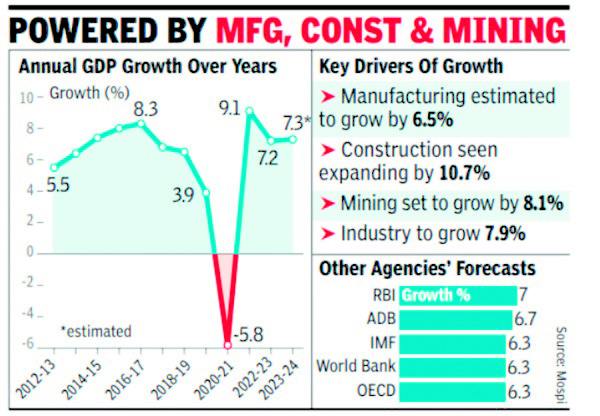The Indian economy is expected to grow 7.3 per cent in the current financial year 2023-24, remaining the fastest-growing major economy, the National Statistics Office (NSO) said on Friday.
However, these are early projections for 2023-24. Improved data coverage, actual tax collections, expenditures incurred on subsidies, and data revisions made by source agencies would have a bearing on subsequent revisions of these estimates.
India’s economy grew 7.2 per cent in 2022-23 and 8.7 per cent in 2021-22.
The first advance estimates of GDP come after the Reserve Bank of India (RBI) raised its growth forecast last month by 50 basis points to 7 per cent from an earlier estimate of 6.5 per cent.
The upward revision by the RBI and the NSO comes on the heels of India reporting more-than-expected July-September quarter growth.
The Indian economy grew 7.6 per cent during the July-September quarter of the current financial year 2023-24, remaining the fastest-growing major economy. India’s GDP growth for the April-June quarter grew 7.8 per cent.
Strong rabi crops sowing despite the late harvest of kharif crops in some states; manufacturing sector is gaining strength with easing input cost pressures; and a pick-up in demand conditions, according to RBI Governor Shaktikanta Das, were some of the reasons for the revision in 2023-24 growth projections.
Further, NSO estimates showed that the manufacturing sector is estimated to expand 6.5 per cent in 2023-24, compared to 1.3 per cent the preceding fiscal.
Construction sector output is expected to grow 10.7 per cent, up from 10 per cent in the previous year, NSO data showed.
In December, RBI elevated its growth forecast for FY24 to 7% from its initial estimate of 6.5% citing robust growth in high-frequency indicators.
Another contributing factor is the unexpectedly strong GDP figure for the September quarter. The Indian economy demonstrated a faster-than-expected growth of 7.6% year-on-year during this period, following a 7.8% expansion in the previous quarter.
Consequently, several private economists revised their annual estimates upward in response to these positive economic indicators.
Some economists, however, expect India’s full-year economic growth to range closer to RBI’s forecast of 7%, as government expenditure, which was high during the first eight months of the ongoing fiscal year, is expected to tapper in the ongoing fourth quarter.
The government’s GDP forecast for FY2024 is essentially based on the April-November data available to it, said economist Pronab Sen, a former chief statistician of the Indian government.
The first advance estimate is the government’s inaugural GDP projection released in January. It employs the benchmark indicator method and draws on provisional data from high-frequency indicators.
Comparing these indicators with the preceding year’s figures, the government assesses the performance of various high-frequency indicators in the initial two or three quarters of the fiscal year.
The assessment incorporates provisional figures of consumer inflation, the Index of Industrial Production (IIP), revised fiscal estimates, and financial results from listed companies, among other key indicators.
The estimate released by the government for the current fiscal year came ahead of the interim Budget presentation for 2024-25 scheduled for February 1. The finance ministry will incorporate this first advance GDP estimate into its budgetary calculations.

















